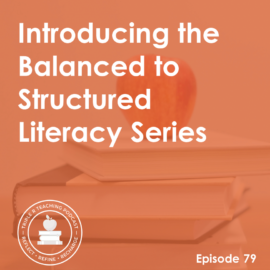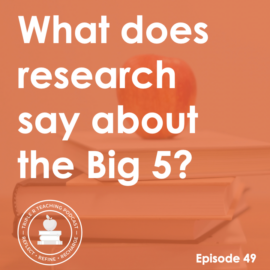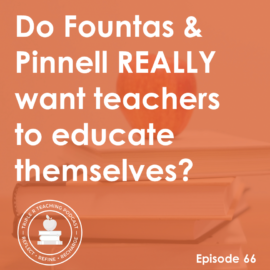
TRT Podcast#53: 4 Common misconceptions about teaching sight words
Should we use the Dolch grade-level lists to help us decide which sight words to teach? Should we teach our students to memorize sight words as wholes? And should beginning reading instruction START with sight words? Get answers to these questions and more as we look at common misconceptions surrounding the teaching of sight words.
Listen to the episode here
Full episode transcript
Hello! Anna Geiger here from The Measured Mom, and I'm so glad to welcome you to another Triple R Teaching podcast episode! Today, we're going to talk about sight words, specifically four common misconceptions about sight words.
The first misconception that people have about sight words is that they are words that cannot be sounded out. For example, the word "the" would be a sight word.
Many people still define sight words this way, as words that kids cannot sound out, words they have to simply memorize, but this definition is actually not correct. Sight words can certainly be irregular, but the definition of sight words is not "words kids can't sound out."
Reading researchers have a different definition of sight words. It's really good to refer to David Kilpatrick's definition. He says that "a sight word is a word that is instantly and effortlessly recalled from memory, regardless of whether it is phonically regular or irregular." A sight word vocabulary refers to the pool of words a student can effortlessly recognize.
Some people use the terms, "sight words" and "high frequency words" interchangeably, but they're not the same thing.
A high frequency word is one of the words that is most commonly used in the English language. A high frequency word can be regular as in "and," or it can be irregular as in "the." The goal is to help our students turn these high frequency words into their own personal sight words, words that they can recognize instantly - preferably within a second.
Having definitions straight is always important as we move forward,so I wanted to start with that one. Sight words are words that students know automatically. They are not necessarily phonically irregular words.
Misconception number two, we should use the Dolch grade level sight word lists as a guide when choosing words to teach our students.
Now, first of all, there's nothing wrong with referring to the Dolch and Fry sight word lists. For high frequency words our students need to know, I certainly refer to those lists. However, it's good to know where Dolch and Fry were coming from.
Edward Dolch and Edward Fry, both Edwards, which is kind of funny, were advocates of the whole word approach, so they were not big on teaching phonics. Not that they necessarily said you shouldn't, but they thought that it was secondary. In fact, in his book, "Teaching Primary Reading," Edward Dolch said that first graders should only learn sight words and teachers should wait until second grade to introduce phonics. So that's obviously NOT the path we want to follow, especially if you've been following along with my science of reading episodes.
So we have to be careful. Dolch and Fry don't espouse a lot of really great ideas about teaching reading when it comes to high frequency words. However, like I said, their lists are helpful because they help us know what words are most common. These are good words for children to know automatically.
The problem with the Dolch words is the grade level categories. I'm not exactly sure how those came about, but I believe they have to do with how often those particular words were present in grade level text. So for example, a third grade level text, what high frequency words were most present in third grade versus kindergarten and so on. Now where exactly they got the grade level text, that's something else I don't know. But if you take a look at the word lists for Dolch, the grade level word lists, you're going to start to wonder a little bit, who came up with this stuff? Because if you look at the third grade level list, it has these words "cut, got, hot, if". Those are not third grade level words, by any stretch of the imagination! I certainly hope that a child who is reading as they should be by third grade does not need to memorize those words! They read them automatically because they learned a long time ago how to read vowel-consonant and consonant-vowel-consonant words. It's silly.
Similarly, some of the words on the kindergarten list are pretty tough, like "please" and "pretty." I'm not sure why it's necessary to teach kids to learn those long words by sight in kindergarten. So yeah, the Dolch and Fry sight word lists can be a good reference for high frequency words, but are not so good when it comes to knowing WHEN to teach them.
Misconception number three is one that Dolch and Fry had themselves, that we should teach sight words as whole words.
We talked about this way back in our series about the science of reading. We talked about how even skilled readers do not recognize words as wholes, because if you did that, you would have memorized 30,000 to 70,000 words. That's how many words you recognize instantly without having to sound out or guess. Your brain cannot do that.
The only way you know all these words so quickly is because you've gotten really good at a mental process called orthographic mapping. Orthographic mapping is that you connect each individual sound to each individual letter or letter pair in the word. You're connecting the phonemes to the graphemes very, very, very, very, very, very fast. You have gotten really good at that because you're good at phonic decoding and phonemic awareness.
That's what we want our students to become good at, decoding and phonemic awareness. Those are two important skills we're going to teach them. As they learn those, they're going to get better at converting those high frequency words into sight words, words they recognize instantly.
So we don't want to start with sight words by giving flashcards and expecting kids to just memorize the shape of the word. That's not where we're going. Later in this series about sight words, we'll get very specific about how to teach sight words, but for now we just want to know that a common misconception is that you should teach them as wholes. That is not true.
And finally, another misconception about sight words is that we should START beginning reading instruction with sight words.
This was definitely a misconception that I used to have because as I taught my young children, my preschoolers, to read, I noticed it was a little hard for them to sound out words, but they could memorize words a little bit easier. So that felt like the best way to start. What I didn't realize was that the reason they struggled with sounding out words was because they needed more work with phonemic awareness.
Phonemic awareness is this ability to play with individual sounds in words. So if a child can orally blend, like if you said, put these sounds together, /f/ /i/ /sh/, and they can put them together and say "fish," they're on the path to reading. They're probably going to have some success in sounding out words.
But if they don't understand that words are made of individual sounds, they can't isolate phonemes and they can't segment or blend phonemes, then sounding out words is going to be tough. So it's better to spend time building phonemic awareness and THEN teach kids to sound out words and THEN teach some sight words.
Can you start by teaching a handful of "sight words," words that kids can just recognize instantly, before doing phonics? Kids will probably learn to recognize a few words even if you teach it to them rather quickly, such as "the" perhaps, but you don't want to go too far with that before you're doing phonics.
I really recommend starting with phonics and then teaching a handful of sight words, even if they don't know the phonics patterns, to help them read decodable books.
So for example, if the book says, "The cat is big," a child cannot read "the," unless you just teach them to know that word. And they might not know "is" either if you haven't taught them that "s" can also of say /z/.
So when we're teaching preschoolers or kindergartners to read, we don't want to start with big lists of sight words. We can teach a handful of sight words to use with the decodable texts they are reading, but we want to start primarily with phonics, with sounding out words. And if that's not working, it's because we need to go back and make sure we've got phonemic awareness well in hand.
So let's quickly review those four common misconceptions when it comes to sight words.
Number one, this idea that sight words cannot be sounded out. Well, it's true that SOME high frequency words cannot be sounded out. A sight word is really a word you recognize instantly, without needing to sound out or guess. Our goal is that our students convert high frequency words into sight words, their own personal sight words.
A second misconception is that we should use the Dolch grade level word lists as a guide for deciding when to teach words. If you take a close look at the word list, you'll find out whoa, that doesn't really make sense! Look at where they all go. There's CVC words in the third grade list. It doesn't make sense at all. What you really should be doing is thinking about the phonics lessons that you're teaching and try to incorporate the high frequency words with your phonics instruction, but we'll get to that in a future episode.
Number three, a misconception is that we should teach sight words as wholes. This idea has been prominent for a long time. Certainly Edward Dolch and Edward Fry, the creators of the most popular high frequency word lists believe this. I mentioned that one of them even said that we shouldn't teach kids to sound out words until second grade. That is a problem because it bypasses orthographic mapping, which as you recall is that children and adults connect sounds to letters, phonemes to graphemes. So no, we should not teach sight words as individual whole words. We should call attention to the parts of the word that are phonically regular, and then study the parts that are not. But again, we'll save this for a future episode.
Finally, we should begin reading instruction with sight words. That is another misconception. In fact, we want to start with phonics. If children are struggling to sound out words, that means they need work in phonemic awareness, and we need to go back and build that before we focus too heavily on sounding out words.
So I hope that gave you a few things to think about. I look forward to joining you next time to teach more about sight words. In the meantime, I recommend checking out my ten part sight word series on the blog, The Measured Mom. We talk about the difference between sight words and high frequency words, the differences between the Dolch and Fry lists, how to teach sight words, how we should approach sight words in preschool and kindergarten, sight words organized by phonics skill, and a whole lot more.
You can check out that series by going to themeasuredmom.com/sightwordseries. One more time that link is themeasuredmom.com/sightwordseries.
You can check out the show notes for this episode, by going to themeasuredmom.com/episode53. Thanks for listening. And I'll talk to you again next time!
Sign up to receive email updates
Enter your name and email address below and I'll send you periodic updates about the podcast.
Check out these posts from our sight word series!
- What is the difference between sight words and high frequency words?
- What is the difference between Dolch and Fry sight words?
- How to teach sight words
- Should we teach sight words in preschool?
- Sight words organized by phonics skill







Kristy
Hi Anna,
I am posting all the way from Australia! I absolutely love your podcasts and have learnt so much about the science of reading. I am confused on one thing though which I’m hoping you can clarify. I thought I heard on this podcast episode that as even skilled readers we cannot memorise all words as a whole. Does this mean that we (adult proficient readers) still use orthographic mapping to retrieve words from our own personal sight word bank in order to read and make meaning? So, say when we read a book, are we using orthographic mapping to read the words we already know, just at a rate much faster than the kids we teach? Or do we just know the words as wholes because we’ve seen them so many times over years and years of being fluent, proficient readers? I’d love to know the role that orthographic mapping plays in adulthood for skilled readers. Do we keep doing it, or does it drop off once we become proficient at reading?
Many thanks! Looking forward to tuning into another podcast episode soon ????????
Anna Geiger
Hi Kristy! You have 30,000-70,000 words in your “sight vocabulary.” All those words have been orthographically mapped. When you encounter a new challenging word (like a technical term) and have to sound it out, it only takes 1-2 exposures for that word to be orthographically mapped as well – that is, you recognize it instantly the next time.
This isn’t to say that kids don’t ever memorize words as wholes – they do some of that at the beginning, but it’s not sustainable and not a good teaching strategy. Does that make sense?
Jody
When should we ask students to write sight words correctly?
For example, If we teach a, the, my, and, & can in Kindergarten, is it ok to expect them to spell them too?
Anna Geiger
My thinking has changed on this over time, Jody, but now I believe that if we’re teaching them to read the high frequency words, we should also be teaching them to spell them. If they’re not ready to learn to spell them, I think we need to ask how we’re teaching them to read the words. While teaching early readers to memorize a few (emphasize FEW) high frequency words is okay to get them started, we really want them to sound out what they can so they can orthographically map the words. Spelling plays a big part in this.
Siobhan
The reason the Dolch list is leveled by grade is that he used the prevailing reading primers as the gauge. So the 1st grade words were from the 1946 reading primers… Fry updated the list in the 1980s, but that still makes it outdated for today 😉
I really appreciate you talking about this! I’m a 16-year veteran, National Board Certified Teacher, but the more senior teachers don’t listen to me because they keep saying their way works (memorizing, calling all memorized words sight words, not understanding the importance of “decoding” the sight words). Ugh. Thank you for sticking up for research-backed practices!
Anna Geiger
Thanks for clearing that up, Siobhan – and thanks for working to be a voice for change at your school! Your kind words are very appreciated. 🙂